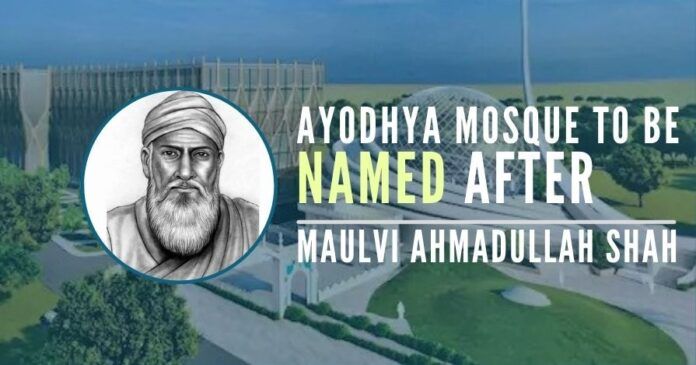
Trust decided to dedicate New Ayodhya Mosque to Maulvi Ahmadullah Shah
Invader Mughal Emperor Babar’s name is not acceptable to the many in the Muslim community for the new mosque to be built in Ayodhya. The proposed mosque in Ayodhya that is set to be built following the Supreme Court verdict in the Babri Masjid case may be named after Maulvi Ahmadullah Shah, the warrior of the 1857 mutiny against the British. The Indo Islamic Cultural Foundation, the trust constituted by the Sunni Waqf Board to oversee the construction of the mosque, is seriously considering naming it after Shah, who was known as the ‘Lighthouse of Rebellion’ in the Awadh region[1], Trust Secretary Athar Hussain said.
After the Trust was formed, there have been discussions on whether the mosque should be named after Mughal emperor Babar or some other names be given. The Babri mosque was named after Babar. To make the Ayodhya mosque project a symbol of communal brotherhood and patriotism, the Trust has decided to dedicate the project to Shah, who represented these values and was also a true follower of Islam, according to Trust sources. “The Trust is thinking very seriously over the proposal of dedicating our Ayodhya Mosque project to the great freedom fighter Maulvi Ahmadullah Shah. We have got suggestions regarding the same from different platforms. It is a good suggestion. We will officially
announce it after deliberations,” said Hussain.
The State Government allotted a five-acre land in Dhannipur village in Sohaval Tehsil of Ayodhya. The blueprint of the mosque was unveiled on December 19.
Maulvi Ahmadullah Shah was martyred on 5 June 1858. British officers like George Bruce Malleson and Thomas Seaton have made a mention of his courage, valour and organisational capabilities. Malleson has repeatedly mentioned Shah in the History of Indian Mutiny, a book on the Indian revolt of 1857. During the freedom struggle, Shah had launched revolts in the Awadh region. He made the local mosque, Masjid Sarai, located in Chowk area of Faizabad his headquarters. As he liberated Faizabad and larger part of Awadh region, he used the premises of this mosque to hold meetings with rebel leaders.
According to researcher and historian Ram Shankar Tripathi, “Besides being a practising Muslim, Shah was also the epitome of religious unity and Ganga-Jamuni culture of Ayodhya. In the revolt of 1857, royalties like Nana Sahib of Kanpur, Kunwar Singh of Arrah fought alongside Shah. His 22nd Infantry Regiment was commanded by Subedar Ghamandi Singh and Subedar Umrao Singh in the famous Battle of Chinhat.”
Supreme Court on November 9, 2019, had ruled in favour of the construction of a Ram temple at the disputed site in Ayodhya and directed the Centre to allot an alternative five-acre plot to the Sunni Waqf Board for building a new mosque at a “prominent” place in the holy town in Uttar Pradesh. The State Government allotted a five-acre land in Dhannipur village in Sohaval Tehsil of Ayodhya. The blueprint of the mosque was unveiled on December 19.
[with PTI inputs]
References:
[1] Ahmadullah Shah – Wikipedia
- Prime Minister Narendra Modi: A Gujju businessman who does not invest his precious time for a losing battle - April 13, 2024
- NIA arrests two accused Shazib and Taahaa in Bengaluru’s Rameshwaram Cafe blast case from Kolkata - April 12, 2024
- National Herald scam: Adjudicating Authority upholds Rs.752 crore assets attached by ED - April 11, 2024











[…] खबर को अंग्रेजी में यहाँ […]